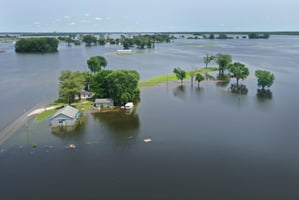Wildfires continue to devastate California, claiming over 25 lives and burning more than 40,000...
Big Changes Are Coming to Flood Insurance — Keep Your Clients Covered

New Fannie Mae and Freddie Mac flood insurance requirements are creating both challenges and opportunities for insurance agents who serve multifamily clients.
Likely driven by the rising frequency and severity of flooding, certain properties located in the 500-year floodplain will now be required to have flood insurance.
This change comes from Fannie Mae’s Multifamily Selling and Servicing Guide and Freddie Mac’s Multifamily Seller/Servicer Guide. According to the guides:
- For multifamily properties in a Tier 1 named storm county, if the property policy’s named storm coverage does not include flooding from storm surge, the borrower must maintain separate flood insurance for any buildings located in a FEMA 500-year flood zone.
- The required coverage amount must be at least equal to the maximum building coverage available under the NFIP for that property type, or the building’s full replacement cost if it is less than the NFIP maximum. If the replacement cost exceeds NFIP limits, excess flood coverage may be needed to meet lender requirements.
- When flood insurance is required, multifamily property owners must also carry Business Income (BI) or Rental Value (RV) coverage. For flood-related BI/RV coverage, the deductible may not exceed 15 days if expressed in time, or $100,000 if expressed as a dollar amount.
While this is not a federal mandate, both Fannie Mae and Freddie Mac are now requiring lenders to enforce it.
What This Means for Agents: Opportunities and Challenges
The new Fannie Mae and Freddie Mac requirements create both an opening and a hurdle for insurance agents working in the multifamily space.
- More Properties Needing Flood Coverage
Multifamily properties in FEMA 500-year flood zones (Zone X500) that previously had no flood requirement will now need flood insurance in certain situations. Agents who can quickly identify these properties and educate their clients on these obligations can become a trusted resource for lenders and property owners. - Need for Access to Multiple Flood Markets
Relying solely on NFIP policies may not be enough. Lenders can require coverage that exceeds NFIP limits, which are currently $500,000 per building for multifamily or commercial properties. To meet these needs, agents will need relationships with private flood markets and excess flood carriers who can layer coverage above NFIP limits. - Business Income or Rental Value Coverage Gap
Perhaps the biggest challenge will be the BI or RV requirement. This coverage is not available through the NFIP, and many private flood insurers do not offer it at all. Agents who know where to place BI or RV coverage, whether through specialty flood markets or as part of broader property programs, will have a competitive advantage for serving their clients. - The Opportunity
These changes will leave many clients uncertain about what coverage they need and how to secure it. Agents who can deliver a one-stop solution that includes primary NFIP coverage, private flood coverage, excess flood coverage, and BI or RV coverage will not only help their clients stay compliant but also strengthen long-term relationships.
Get Appointed with AFR Now
By getting appointed with AFR Insurance Services, you can:
- Keep your clients compliant with lender requirements and avoid coverage gaps that could jeopardize closings.
- Access competitive flood insurance options through the NFIP, private markets, and excess flood markets to provide the coverage levels lenders require, even when they exceed NFIP limits.
- Provide business interruption coverage that meets the new requirements and business needs.
- Leverage AFR’s expertise in flood regulations, mapping, and underwriting to guide clients through new rules with confidence.
- Retain your book of business by ensuring clients don’t turn to other providers when these requirements become necessary.
- Deliver high-quality quotes, fast turnaround, and personalized support for each client’s unique risk profile.
These changes are already rolling out. If you’re not prepared, your clients could be forced to buy coverage elsewhere — and you could lose valuable business.
Get appointed with AFR today to provide your clients with the right coverage options—right when they need them.


.png?height=200&name=Flooding%20Cost%20(1).png)
